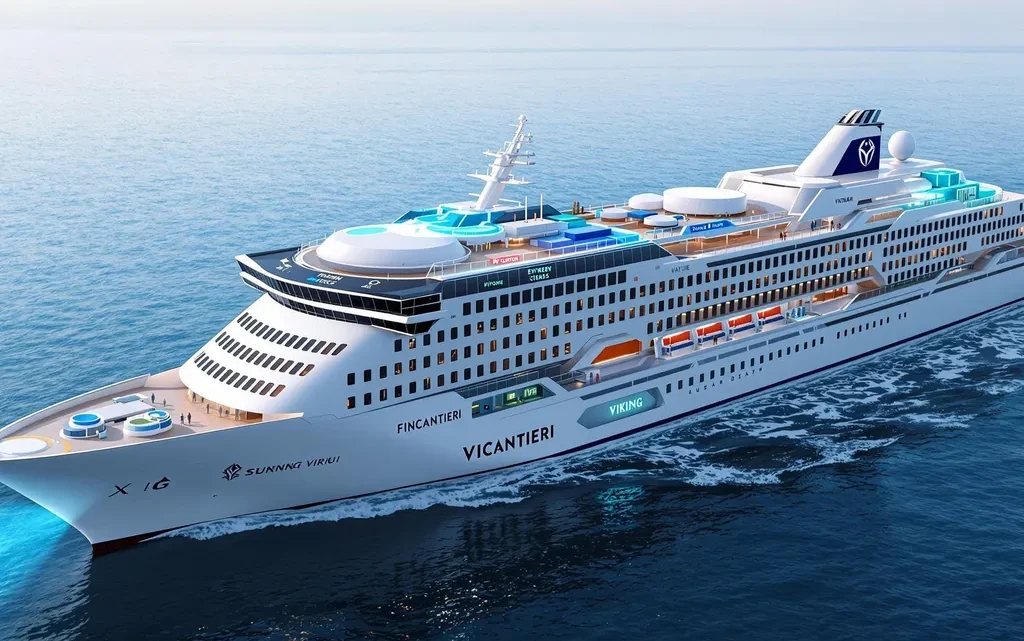
Fincantieri and Viking Set Sail with First Hydrogen Cruise Ship: A Game-Changer for Clean, Zero-Emission Cruising
April 9, 2025Fincantieri and Viking are joining forces on something that could truly change the game for cruise travel: the first-ever hydrogen cruise ship, expected to set sail in 2026. This isn’t just about building a new kind of ship — it’s a bold step toward a cleaner, greener future for the entire maritime industry.
By putting hydrogen fuel cells at the heart of the ship’s propulsion system, they’re making a clear statement: the days of polluting fuels are numbered. As countries tighten climate regulations and travelers grow more eco-conscious, this kind of innovation isn’t just cool — it’s absolutely necessary.
Meet the Players: Making Clean Cruising a Reality
On one side, you’ve got Fincantieri — one of Italy’s, and frankly the world’s, heavyweights in shipbuilding. They’ve been in the game since the 1950s and have cranked out everything from luxury liners to naval vessels. Now, they’re turning their focus to sustainability, and this hydrogen ship is a big part of that vision.
On the other side is Viking, the Swiss-based cruise company known for its elegant river and ocean tours that focus on culture and experience. With this project, Viking is going beyond leisure; they’re committing to a whole new kind of travel — one that protects the very environments its guests come to see. They’re not just doubling down on innovation — they’re betting on a cleaner future.
Why Now? What’s Pushing This Forward
For decades, cruise ships (and most of the maritime world) have relied on heavy fuel oil — one of the dirtiest types of fuel around. Sure, liquefied natural gas (LNG) emerged as a cleaner alternative, but it’s more of a halfway point than a real solution. If we’re serious about cutting emissions from international shipping, hydrogen is the end game.
Flash forward to today, and hydrogen’s momentum is picking up globally — from hydrogen ferries in Norway to trains in Germany, also have just been a few days away since the first hydrogen tugboat was announced. But putting it to work on a cruise ship of this size? That’s a whole new level — and it’s what makes this Fincantieri-Viking partnership so exciting.
But let’s not sugarcoat it — designing a vessel to run on hydrogen isn’t just plug-and-play. Hydrogen storage presents real technical challenges. Whether it’s compressed gas or supercooled liquid hydrogen, storing it safely onboard demands cutting-edge tech and strict safety protocols. Thankfully, recent leaps in cryogenics and materials engineering are making it more doable than ever.
Bigger Than Just One Ship
This isn’t a flashy one-and-done PR move. If it works, this project could be the spark that lights a larger shift across the entire shipping industry. It might kickstart more investment in hydrogen infrastructure, like fueling stations at ports, and boost demand enough to help drive down the cost of green hydrogen itself.
And for Viking, the first cruise line to roll out a zero-emission voyage? That’s the kind of move that can really separate you from the crowd — especially with more travelers prioritizing sustainability when they book their next trip.
How It Stacks Up Globally
While others are dabbling — like Havyard Group in Norway looking at hydrogen ferries, and hydrogen-powered trains rolling out in various parts of Europe — cruising is a different beast entirely. Providing all the luxury, comfort, and power a cruise ship demands, while running on clean energy? It’s ambitious, and it raises the bar for what’s possible in maritime innovation.
What Lies Ahead: The Road Isn’t Easy
Let’s be real, there are still hurdles. The infrastructure for hydrogen — from production to distribution — is still patchy and expensive. Safety regulations are evolving, and the cost of green hydrogen remains a major challenge. But all major technological revolutions started with questions and challenges like these.
The difference now is that momentum is building. As the world turns its attention toward a more sustainable energy future, hydrogen-powered ships won’t just be a novelty. They’ll be a necessity.
The Takeaway: More than a Voyage
What Fincantieri and Viking are doing isn’t just about building a ship — it’s about making a bold move toward reimagining cruise travel. With this joint effort, they’re showing the world that zero-emission cruising isn’t some faraway dream. It’s almost here — and it’s very, very real.
If this initiative takes off, it won’t just impact Viking’s fleet — it’ll set the tone for cruise lines and shipping companies everywhere. The message is clear: the era of diesel is sailing into the sunset. The hydrogen horizon is where we’re headed next.
About Fincantieri: Headquartered in Italy, Fincantieri is one of the largest and most forward-thinking shipbuilders in the world. From luxury cruise liners to advanced military vessels, the company is now throwing its weight behind sustainable innovation and future-ready propulsion tech — and this hydrogen cruise project is proof they mean business.



 With over 15 years of reporting hydrogen news, we are your premier source for the latest updates and insights in hydrogen and renewable energy.
With over 15 years of reporting hydrogen news, we are your premier source for the latest updates and insights in hydrogen and renewable energy.
Fascinating. As the electrolysis challenge is solved, compression and storage remain. I propose we ” let hydrogen be hydrogen “. Rather than trying to change its density and other unique properties, store it under reduced pressure. An extreme case would be a dirigible towed behind the ship. As the requirements for a denser fuel source increased the container might look like a lightweight barge. Thank you for including your readers. Richard McArdell
How about Hydrogen from Seawater? There is a plentiful supply of it! UK company
latentdrive.co.uk Are just experimenting with their SeaStack electrolizer in Portland Harbour by Weymouth on the south coast of England where Cruise Ships occasionally dock.